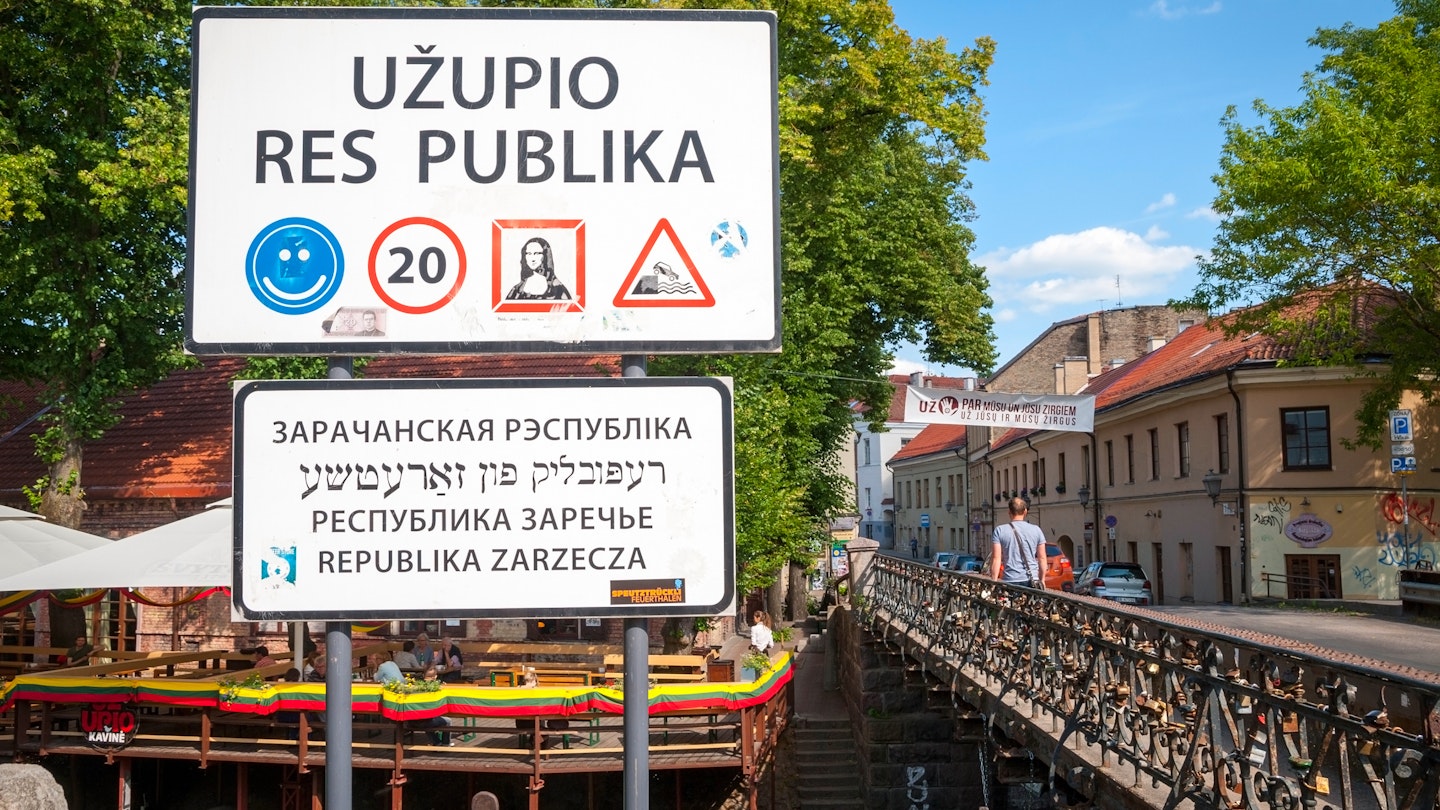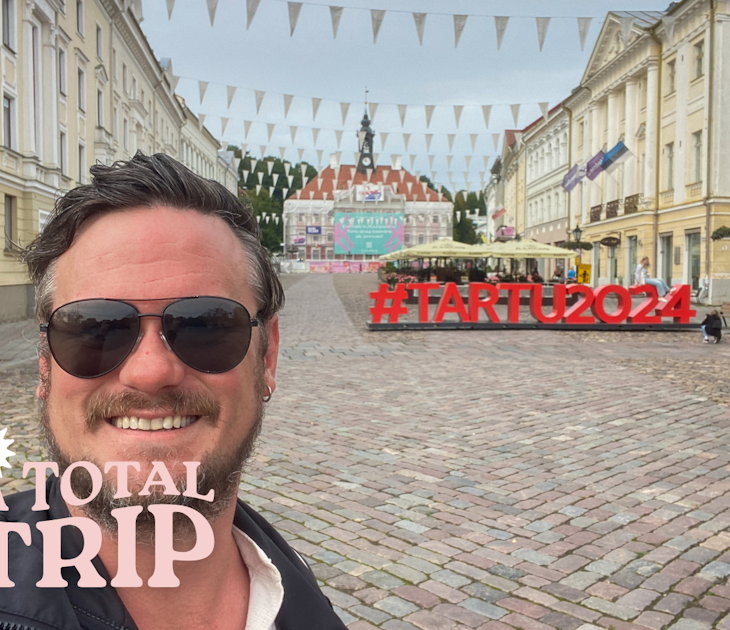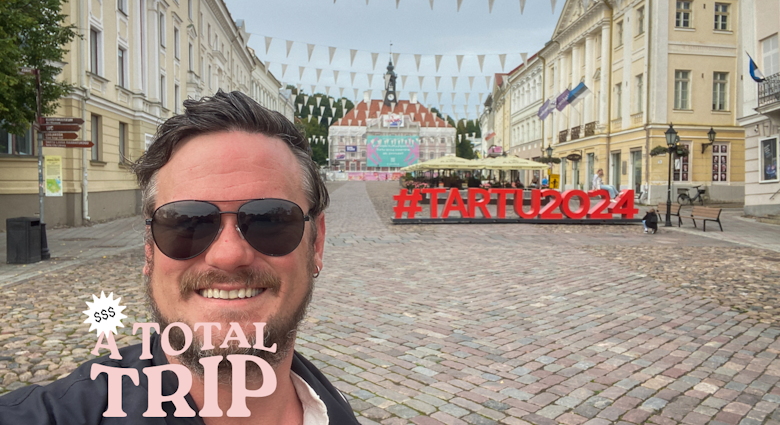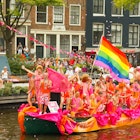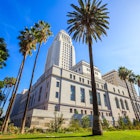Laden with love-locks and traversed by a steady flow of visitors, the small bridge crossing over the Vilnia River in Lithuania’s capital, Vilnius, could be any in Europe. But this bridge is actually a border – albeit with no passport control – to a ‘country’ within a country: the quirky, creative, self-declared Republic of Užupis.
Amidst Vilnius’ richly storied past, the tale of its breakaway enclave of artists and eccentrics is unique. Unconventional and compact, Užupis is a neighbourhood perfect for an afternoon of exploration.

The neighbourhood beyond the river
Nestled in a meander of the narrow and fast-flowing Vilnia River, Užupis (meaning ‘beyond the river’) was in centuries past the ideal spot for mills. Traditionally the home of craftspeople plying their trades, it was always the suburb of people with modest means but, under Soviet rule in the 20th century, the neighbourhood declined rapidly into dereliction. An undesirable place to be, most Vilnius residents avoided the area altogether, and the last undeveloped, dilapidated buildings can still be seen down certain streets in the district, a reminder of its deprived past.
After Lithuania gained independence from the USSR in 1990, artists who had been stifled under Soviet rule took advantage of Užupis’ bargain rents and began to make the district their home. A community of like-minded, free-spirited creatives was in the making.
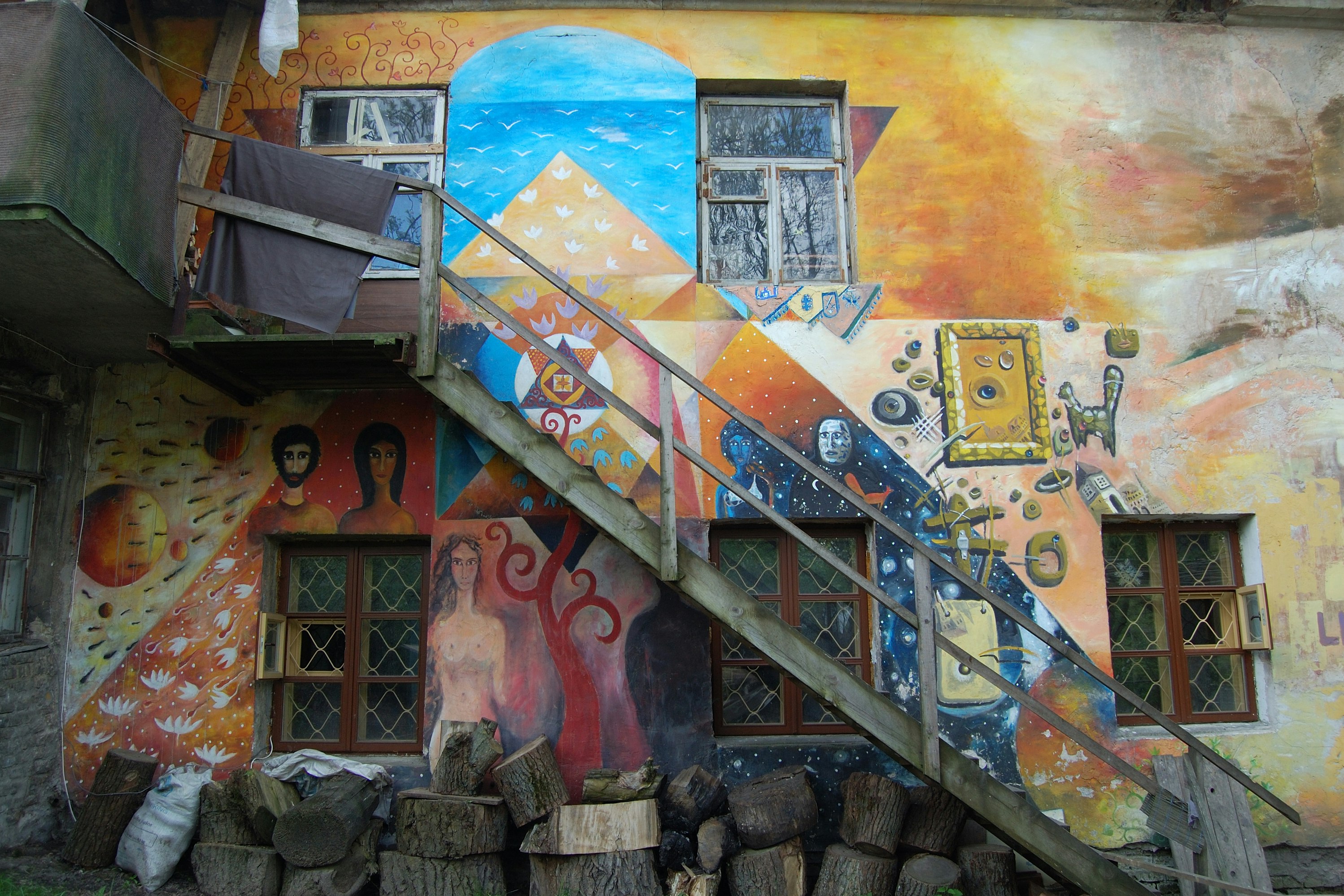
Although it’s still unclear whether the move was an elaborate piece of performance art or a genuine political statement, on 1 April 1997, residents of the neighbourhood banded together to declare independence from Lithuania, stating that the neighbourhood was now to become the Republic of Užupis. They followed through on their resolve, creating a 41-point constitution (38 articles and three mottos), a flag, an anthem, and amassing an army of 12. Under the direction of the ‘President’, citizens of this new ‘republic’ were ready to forge ahead with their aim of promoting artistic expression in their creative commune, and the area has since become celebrated as Vilnius’ answer to Montmartre in Paris and Christiania in Copenhagen. And while the enclave isn't legally recognised, residents in Vilnius have embraced the neighbourhood's independent spirit.
Symbols of ‘independence’
Užupis is a small district, easy to wander through on foot, and several signs of the ‘republic’ can be seen on a stroll through its streets. The first indicator is on the main bridge to the neighbourhood, an irreverent sign pronouncing 'Užupis Res Publica', complete with icons depicting the speed limit, the Mona Lisa, and a car falling into the river.

The most important sight, though, is Užupis’ constitution, drafted by founders Romas Lileikis, a poet and film-maker, and Tomas Čepaitis, a librettist. The document is displayed on several mirrored plaques on Paupio gatvė. Among the baffling list of articles, there are some practical points, such as article 2: ‘Everyone has the right to hot water, heating in winter and a tiled roof’, and article 20: ‘No one has the right to violence’.
But alongside these sensible inclusions, the contrary constitution also features some perplexing declarations, for example, article 12: ‘A dog has the right to be a dog’, as well as some more touching ones: 6. ‘Everyone has the right to love’.
First displayed in Lithuanian and English, the constitution has since been translated into several languages, including French, Russian and Yiddish and, since 2002, the translation tally has been updated annually to include additional languages; 2018 heralds the introduction of an Esperanto version.
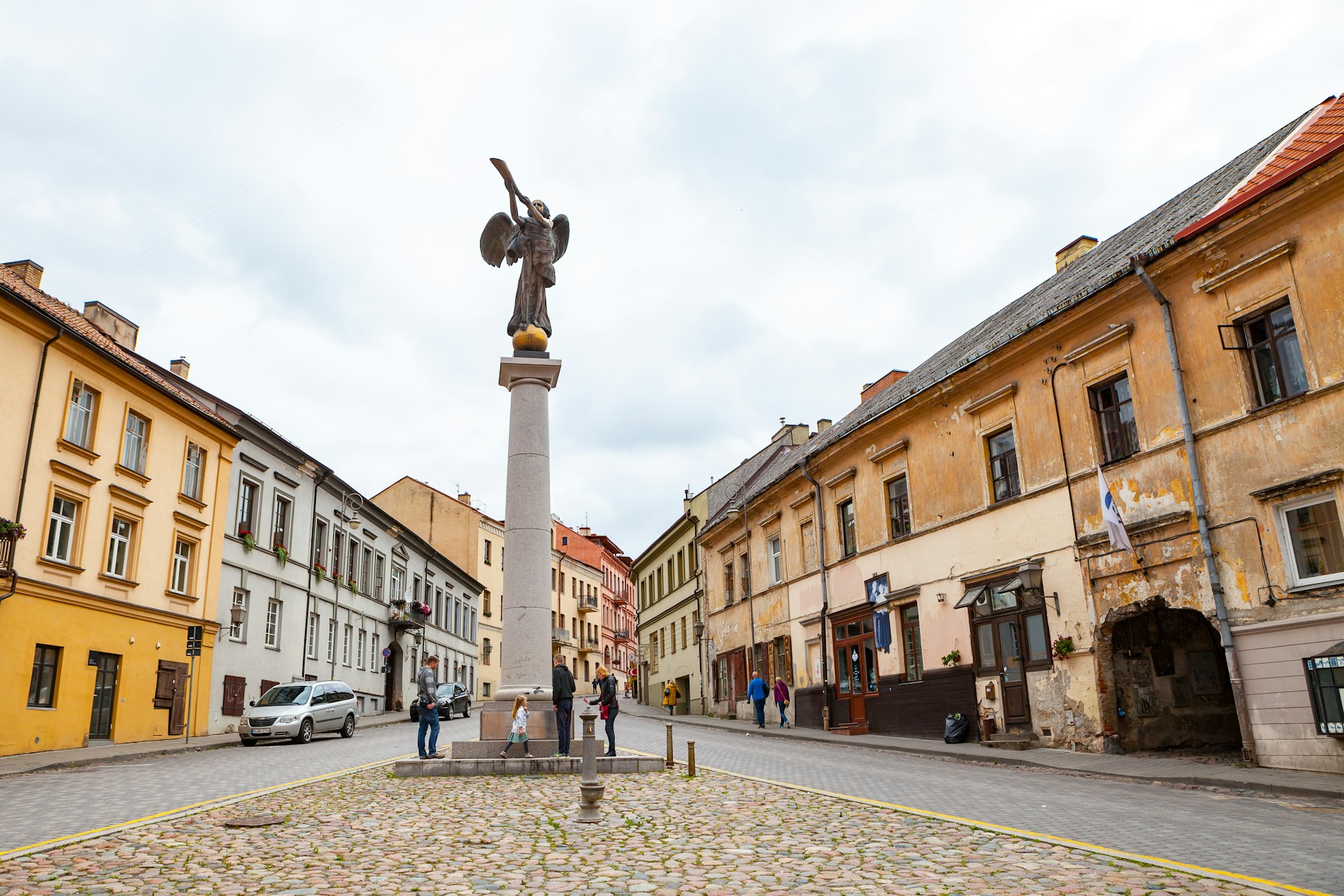
On the wall next to the constitution is the image which can be seen on the official flag of Užupis, (actually four flags; a different colour depicting each season). The open hand with a circular hole in the palm is said to represent openness.
Paupio gatvė opens onto the main square, where a statue of a trumpeting angel stands high on a pillar, surveying the district. Unveiled on Užupis’ ‘Independence Day’ in 2002, the angel has become the symbol of the republic, and replaced a peculiar sculpture of a large egg, which now stands on Pylimo gatvė, outside of the district’s borders.
Užupis’ arts and crafts on display
Ironically, following rapid gentrification, this once impoverished, bohemian area is now one of the most expensive places to buy and rent property in Vilnius. The neighbourhood’s population has blossomed to 7000 – with around 1000 artists amongst this number – and, although it has become something of a visitor attraction in recent years, its roots as a hub for creativity remains. A wander down any of the streets of studios and workshops reveals street art and curiosities at every turn, from murals adorning buildings, to a window surround decorated with tiles portraying various birds alongside a grinning Ghandi-like face, while nearby a brass relief of a booze-addled figure hugs a bottle of ale as he haunts the exterior wall of bar.

For a more formal insight into the work produced by the artists working in Užupis today, swing by Galera, the exhibition space linked to Užupis Art Incubator (umi.lt), or take a closer look at some of the crafts traditionally practiced in the district at one of the local workshops. Contact The Vilnius Potters’ Workshop (facebook.com/VilniausPuodziuCechas; conveniently situated opposite the constitution on Paupio gatvė) for a tour and to learn the history of pottery and ceramics in the area.
For a real treat, try your hand at being a blacksmith at Užupis Blacksmiths Museum-Gallery. The historical importance of these most treasured of tradespeople is entertainingly explained and basic techniques are demonstrated at the anvil. The museum also has a small shop selling ironware including a number of Lithuanian Suns, an amalgamation of the Christian cross and pagan imagery unique to the country.
The fine art of eating and drinking
Amidst an atmosphere of creativity, the culinary arts have not passed this district by. A number of recently-opened restaurants in Vilnius have taken inspiration from the New Nordic school, and Sweet Root, in the heart of Užupis, is one such venue. Hyper-local ingredients, many of which are grown in the restaurant’s own garden, are used to create a degustation menu which evolves with the seasons. Springtime dishes include buckwheat porridge with sunflower seeds and spring herbs, and ox-cheek ravioli with beetroot and evening primrose leaves.

Craft beer is gradually beginning to make its mark in Lithuania, and the diminutive Špunka offers up a good selection of beers both local and international. An even more relaxed alternative is café-bar Užupio kavinė, right on the bank of the Vilnia. Grab a spot out on the deck and settle in for some bohemian people-watching.
Making it happen
A number of carriers serve Vilnius Airport, including Wizz Air (wizzair.com) and Ryanair (Ryanair.com), fly from a major European destinations including London Luton. The airport is located just 5km from the city centre, and is served by frequent bus and train services.
Gemma Graham travelled to Lithuania with support from the Lithuanian State Department of Tourism (lithuania.travel). Lonely Planet contributors do not accept freebies in exchange for positive coverage.
